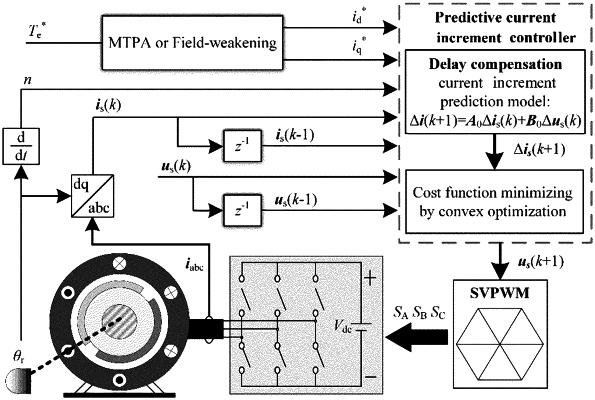| CPC H02P 21/0085 (2013.01) [H02P 21/0017 (2013.01); H02P 21/18 (2016.02); H02P 21/22 (2016.02); H02P 25/022 (2013.01); H02P 27/12 (2013.01)] | 6 Claims |

|
1. A predictive control method of current increment for a permanent magnet synchronous motor under a high-speed operation, wherein the high-speed operation is operated at a speed equal to or higher than 3000 r/min, and the predictive control method of the current increment for the permanent magnet synchronous motor under the high-speed operation comprising the following steps:
(1) establishing a mathematical expression of a stator voltage during one control period according to a position change of a rotor of the permanent magnet synchronous motor during the one control period;
(2) obtaining a continuous time domain current model of the permanent magnet synchronous motor by solving a continuous time domain equation of the permanent magnet synchronous motor;
(3) substituting the mathematical expression of the stator voltage during the one control period into the continuous time domain current model of the permanent magnet synchronous motor for solving solutions to obtain a discrete current prediction model for the permanent magnet synchronous motor under the high-speed operation, and then obtaining a predicted current at a next time point by using the discrete current prediction model;
(4) subtracting a predictive current at a present time point from a predictive current at a next time point to obtain a current increment prediction model for the permanent magnet synchronous motor under the high-speed region, and then obtaining a predicted current increment calculated from the current increment prediction model;
(5) establishing a cost function by taking a squared error at an end of each control period between a preset reference current increment and a predicted current increment as an evaluation criterion, and then minimizing the cost function by solving a convex optimization problem for the cost function to obtain an optimal voltage increment;
(6) superposing the optimal voltage increment on a stator voltage of a present control period to obtain an optimal stator voltage of a next control period, and then apply the optimal stator voltage of the next control period to the permanent magnet synchronous motor.
|